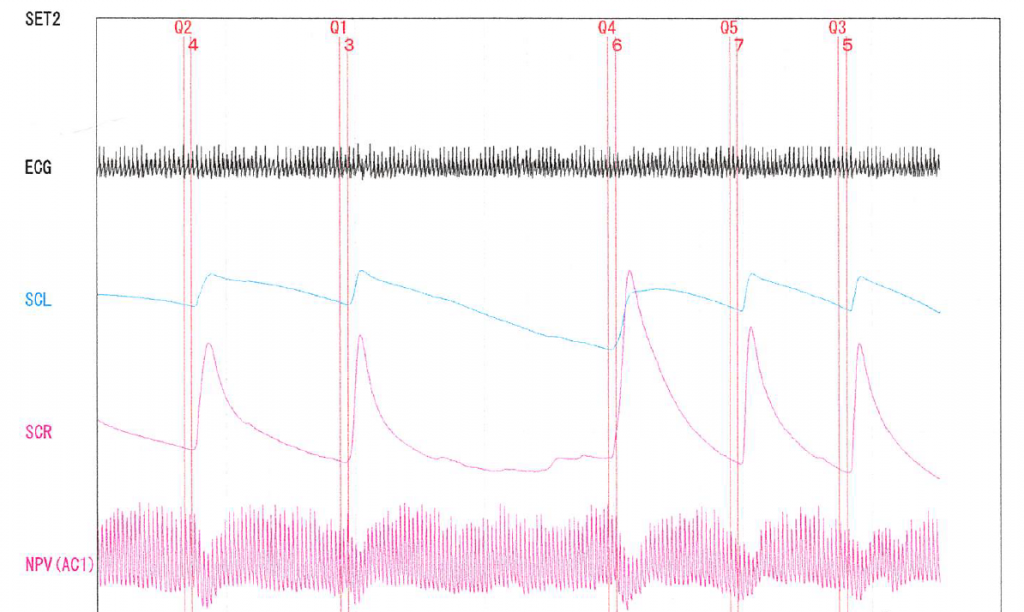On December 18. 2019 Dr. Orthey and a group of students from the Kwansei Gakuin University psychophysiological laboratory of professor Katayama were invited to the forensic lab of Nara prefectural police headquarters to discuss the application psychophysiology techniques in the criminal investigation.
In Japan, the police applies the Concealed Information Test (CIT) to detect if a suspect has knowledge about a criminal event that only the real perpetrator can know. During our visit a police polygrapher demonstrated the first step of the CIT examination, the so called “card test”, on one of our students. In this procedure, the suspect picks one of five playing cards and hides their knowledge of this card. Next, the police polygrapher presents all five answer alternatives one by one while the student rejects all of them.
During this procedure the forensic examiner records several psychophysiological indices of the autonomous nervous system such as sweat, here measured as Skin Conductance Level (SCL) and Skin Conductance Response (SCR).
Below we can see the responses of our student when confronted with the different possibilities. Look at the SCR responses, can you guess which number was printed on his card?
Research has shown that the correct answer elicits a larger SCR response than the other answer alternatives. Theoretically, this elevated response is a consequence of the memory recognition process. Here our student drew a card with the number six on it (Q4). If an examinee was unaware of the correct answer, we would expect a similar response to all answer alternatives.
After the demonstration, our host Mr. Bito gave a presentation on the benefits of a CIT examination which are not already known outside the police to prevent mistaken arrests and false charges in a criminal investigation.
According to him, material evidence can link a suspect to a location or object leading to a hypothetical story detailing the crime event. However, this does not always automatically mean that the suspect is the perpetrator and a false confession could occur. Mr. Bito proposes that the CIT preceding the interview can serves as an additional check to confirm the “story” told by the evidence. In this case a suspect would be tested for factual knowledge about the crime inferred from the physical evidence, and an absence of memory recognition for details of the story would cast doubt on the validity of any confession. However, the CIT cannot be used for this purpose once a suspect has already confessed, because at this point it cannot be excluded that the suspect acquired the information from the confession during the interview. Hence, this type of CIT can only be used after a confession was obtained if the police still holds information only the perpetrator can know, but that was not revealed during the interview.
The CIT is an integral part of the criminal investigation in Japan and therefore the study of psycholophysiological techniques is a valuable endeavor to introduce scientifically validated methodology to real life applications. Similarly, the scientific study of the CIT is an active field devoted to the development of novel indices or paradigms and further improvements of the CIT procedure.
<参考日本語訳>
12月18日,関西学院大学片山研究室所属の博士研究員オータイと学部学生は奈良県警の科学捜査研究所を訪問し,犯罪捜査に用いられる生理心理学的技法について話を伺ったので,その内容を以下に報告する。
日本の警察では,容疑者が犯人しか知りえない情報を知っているかどうか調べるために隠匿情報検査(CIT)が行われている。訪問中,CIT検査に先立って行われるいわゆる“カードテスト”を学生の一人が体験した。カードテストでは,被検査者は5枚のカードから1枚を選択し,それを隠す。検査者はSCRやSCLを含む様々な自律神経系指標を記録しながら,5枚のカードすべてを被検査者に呈示する。掲載している反応は検査を体験した学生の反応であり,SCRの反応から隠されたカードが何か推測できる。
これまでの研究から,隠されたカードがそれ以外のカードより大きなSCR反応を誘発することがわかっている。また理論的には,大きなSCR反応は記憶の再認過程を反映していると考えられている。今回,被検査者の学生は6のカード(Q4)を引いていた。もし被検査者が隠したカードについての知識を持っていなければ,すべてのカードに対して同程度の反応が見られるはずである。
体験の後,科学捜査研究所の尾藤さんから講義を受けた。警察関係者以外にはあまり知られていないことだが,CITは誤認逮捕や冤罪を防ぐことに効果的な側面があるとのことであった。物的証拠は容疑者と凶器などを結び付けるストーリーを構築するが,それは必ずしも容疑者が犯人であることを意味しないし,偽りの自白を導いてしまうかもしれない。そのような場合に,事情聴取より前に行われたCITはそのストーリーの確認に利用できる。具体的には,物的証拠から導かれる事実を知っているかどうか調べることができ,もし知識があると確認できなければストーリーの妥当性に疑問を投げかけることもできる。ただし,事情聴取の中で容疑者が何らかの情報を得てしまうとこの目的には利用できなくなる。上記の目的でCITを行うのであれば,ある情報が犯人にしか知りえない状態に保たれていることが担保されなければならない。
CITは日本の犯罪捜査における不可欠な過程になっており,したがって科学的に妥当な方法を導入するための研究は非常に重要である。同様に,新たなパラダイムの開発やCITの精度の向上に関する科学的研究は現在非常に活発に行われている。

